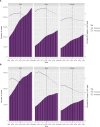Global burden of brain and central nervous system cancer among people aged 20-64 years, 1992-2021 and projections to 2050: a population-based study
- PMID: 40897476
- PMCID: PMC12406826
- DOI: 10.1136/bmjopen-2024-094462
Global burden of brain and central nervous system cancer among people aged 20-64 years, 1992-2021 and projections to 2050: a population-based study
Abstract
Objectives: To estimate the burden, trends, and inequalities of brain and central nervous system cancer (CNS cancer) among adults at global, regional and national level from 1992 to 2021.
Design: Population-based study.
Population: Adults aged 20-64 years from 21 regions and 204 countries and territories (Global Burden of Disease and Risk Factors Study 2021) from 1992 to 2021.
Main outcome measures: Our primary outcomes comprised age-standardised prevalence, incidence, mortality and disability-adjusted life-years (DALYs) for CNS cancers. The analytical framework incorporated temporal trend analysis through annual percentage change (APC) and average APC (AAPC) metrics, complemented by Bayesian age-period-cohort modelling to assess demographic influences. We employed predictive modelling with decomposition techniques to evaluate contributions from age structure shifts, population dynamics and risk factor modifications, while spatiotemporal Gaussian process regression enabled robust smoothing and trend estimation across continuous time-space dimensions. The study specifically applied frontier analysis methodologies to examine epidemiological patterns of prevalence, incidence, mortality and DALYs within the 20-64 years adult population.
Results: From 1992 to 2021, the global age-standardised prevalence (AAPC 1.04 (95% CI 0.91 to 1.18); p<0.001) and incidence (AAPC 0.23 (95% CI 0.14 to 0.31); p<0.001) of CNS cancer among adults aged 20-64 years increased, while age-standardised DALYs (AAPC -0.28 (95% CI -0.34 to -0.22); p<0.001) and mortality (AAPC -0.27 (95% CI -0.34 to -0.2); p<0.001) decreased. The most significant increase in prevalence (AAPC 1.67 (95% CI 1.47 to 1.87); p<0.001) and incidence (AAPC 0.7 (95% CI 0.61 to 0.79); p<0.001) was observed among those aged 20-24 years. The most significant decrease in DALYs (AAPC -0.45 (95% CI -0.55 to -0.35); p<0.001) and mortality (AAPC -0.46 (95% CI -0.56 to -0.36); p<0.001) was observed among those aged 40-44 years. The rate of increase in prevalence and incidence was lower in high sociodemographic index (SDI) (prevalence: AAPC 0.95 (95% CI 0.8 to 1.11); p<0.001), (incidence: AAPC 0.95 (95% CI 0.8 to 1.11); p<0.001) countries compared with low-SDI countries (prevalence: AAPC 0.5 (95% CI 0.43 to 0.57); p<0.001), (incidence: AAPC 0.12 (95% CI -0.07 to 0.31); p<0.001). DALYs and mortality began to decline in high-SDI countries (DALYs: AAPC -0.52 (95% CI -0.73 to -0.31); p<0.001), (mortality: AAPC -0.5 (95% CI -0.7 to -0.3); p<0.001), but these indicators continue to rise in low-SDI nations (DALYs: AAPC 0.45 (95% CI 0.39 to 0.51); p<0.001), (mortality: AAPC 0.38 (95% CI 0.31 to 0.46); p<0.001). Our predictive analysis found that from 2021 to 2050, the number of CNS cancer cases among people aged 20-64 years will be on the rise globally, which is expected to increase from 186 891 to 245 942, an increase of 31.6%.From 1992 to 2021, the global age-standardised prevalence and incidence of CNS cancer among adults aged 20-64 years increased, while age-standardised DALYs and mortality decreased. The most significant increase in prevalence and incidence was observed among those aged 20-24 years. The most significant decrease in DALYs and mortality was observed among those aged 40-44 years. The rate of increase in prevalence and incidence was lower in high SDI countries compared with low-SDI countries. DALYs and mortality began to decline in high-SDI countries, but these indicators continue to rise in low-SDI nations. Our predictive analysis found that from 2021 to 2050, the number of CNS cancer cases among people aged 20-64 years will be on the rise globally, which is expected to increase from 186 891 to 245 942, an increase of 31.6%.
Conclusions: Significant inequalities exist in age-standardised prevalence, incidence, DALYs and mortality of CNS cancer among countries with varying sociodemographic indices. These disparities highlight the urgent need for targeted clinical guidelines and equitable distribution of global health resources.
Keywords: Health Surveys; Health economics; Health informatics; Neurological oncology; Observational Study.
© Author(s) (or their employer(s)) 2025. Re-use permitted under CC BY-NC. No commercial re-use. See rights and permissions. Published by BMJ Group.
Conflict of interest statement
Competing interests: None declared.
Figures





Similar articles
-
Global, regional and national burden of stroke and subtypes burden in women of reproductive age: insights based on Global Burden of Disease 2021.BMC Public Health. 2025 Aug 21;25(1):2872. doi: 10.1186/s12889-025-23869-9. BMC Public Health. 2025. PMID: 40841604 Free PMC article.
-
Global, regional, and national burden of maternal disorders, 1990-2021: a systematic analysis from the global burden of disease study 2021.BMC Public Health. 2025 Jul 29;25(1):2576. doi: 10.1186/s12889-025-23814-w. BMC Public Health. 2025. PMID: 40730990 Free PMC article.
-
Global trends in the burden of alcohol use disorders in the working-age population from 1990 to 2021 and projections for the next 20 years.Front Public Health. 2025 Jul 28;13:1616343. doi: 10.3389/fpubh.2025.1616343. eCollection 2025. Front Public Health. 2025. PMID: 40791621 Free PMC article.
-
Global burden and risk factors of musculoskeletal disorders among adolescents and young adults in 204 countries and territories, 1990-2019.Autoimmun Rev. 2023 Aug;22(8):103361. doi: 10.1016/j.autrev.2023.103361. Epub 2023 May 23. Autoimmun Rev. 2023. PMID: 37230312 Review.
-
National and subnational burden of brain and central nervous system cancers in China and global from 1990 to 2021: results from the global burden of disease study 2021.Arch Public Health. 2025 Jul 28;83(1):195. doi: 10.1186/s13690-025-01683-4. Arch Public Health. 2025. PMID: 40722045 Free PMC article.
References
-
- Allemani C, Matsuda T, Di Carlo V, et al. Global surveillance of trends in cancer survival 2000-14 (CONCORD-3): analysis of individual records for 37 513 025 patients diagnosed with one of 18 cancers from 322 population-based registries in 71 countries. Lancet. 2018;391:1023–75. doi: 10.1016/S0140-6736(17)33326-3. - DOI - PMC - PubMed
MeSH terms
LinkOut - more resources
Full Text Sources
Medical
